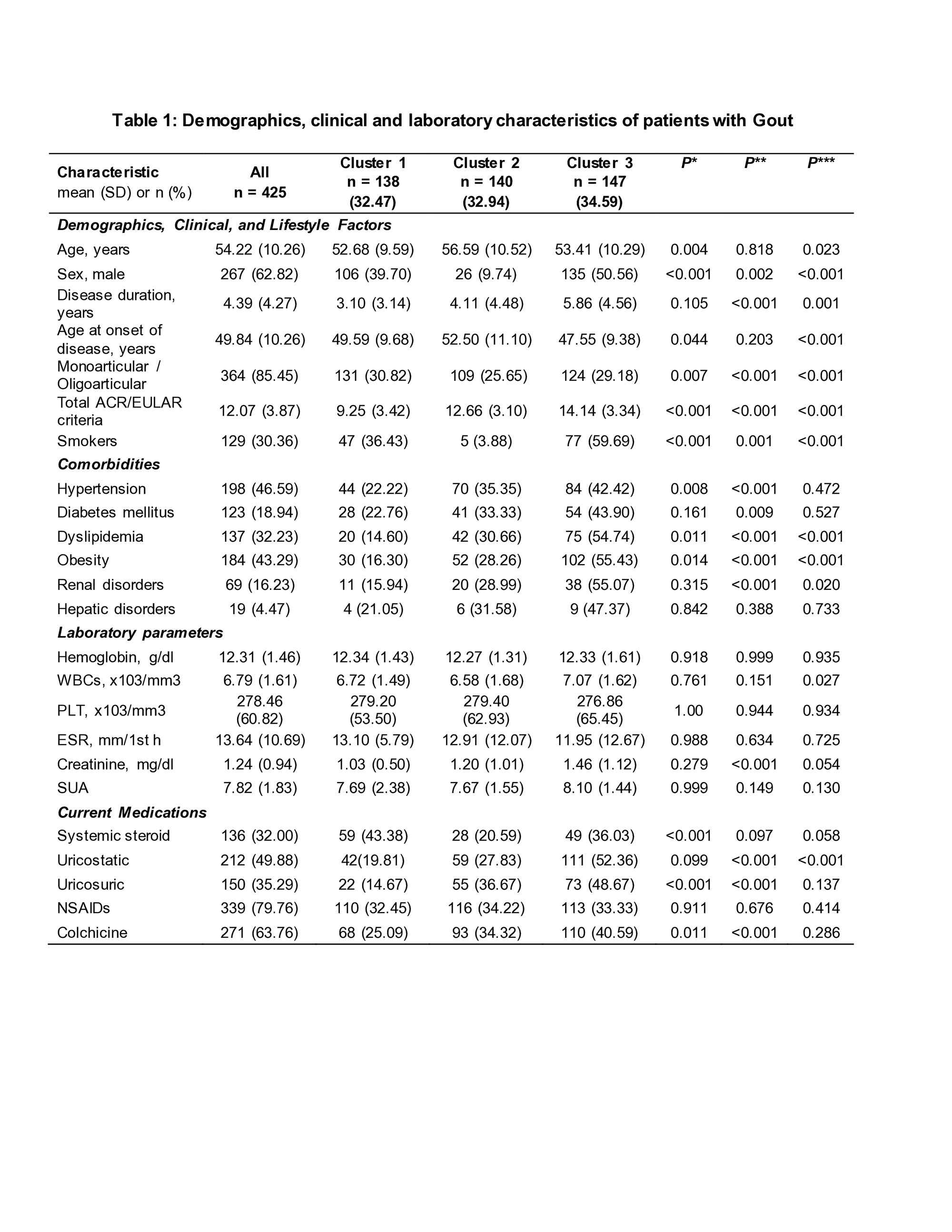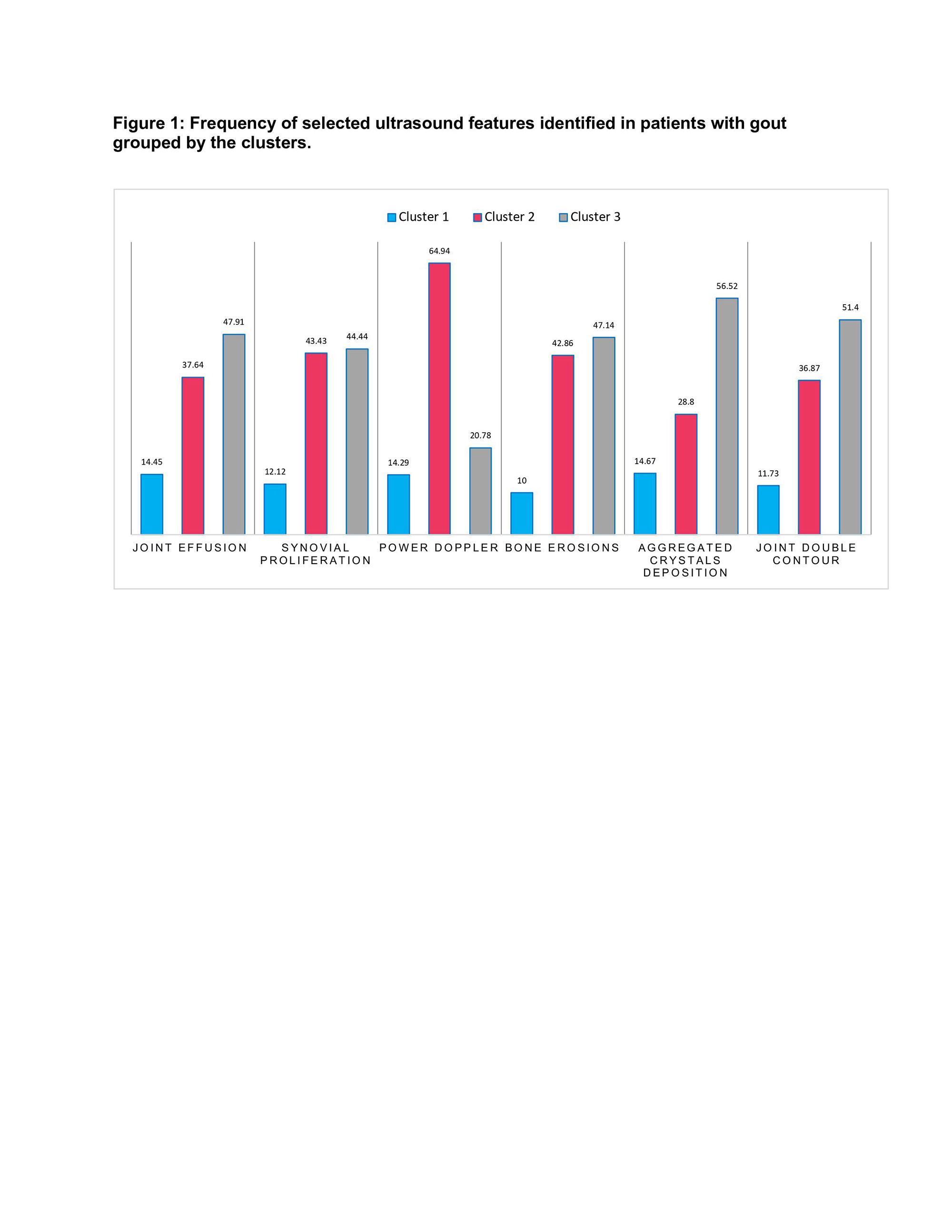Session Information
Date: Monday, November 14, 2022
Title: Metabolic and Crystal Arthropathies – Basic and Clinical Science Poster
Session Type: Poster Session D
Session Time: 1:00PM-3:00PM
Background/Purpose: Gout comprises a heterogeneous group of disorders characterized by inflammatory arthritis associated with comorbidities leading to impaired quality of life, and an extensive burden on health care costs. Musculoskeletal ultrasound (MSUS) has shown great advantages in the diagnosis of gout; with its incorporation in the latest American College of Rheumatology/European League Against Rheumatism (ACR/EULAR) gout classification criteria. Efforts to subtype the disease have been limited to the impact of comorbidities on gout patients, and no attempt has been made to describe how ultrasonographic features combined with clinical and laboratory characteristics categorize the population with gout into subtypes. Here, we applied unsupervised clustering analysis to identify clinically-relevant phenotypes in patients with gout on the basis of MSUS findings and to investigate differences across clusters.
Methods: This was a cross-sectional multicentre study of 425 gouty patients who met the ACR/EULAR classification criteria in the Egyptian College of Rheumatology (ECR)-MSUS Study Group, a nationally representative sample. Variables including demographic, lifestyle factors, clinical manifestations, comorbidities, and laboratory findings were selected for analysis. Musculoskeletal scans evaluated bilateral knee and 1st MTP joints for joint effusion, synovial proliferation, joint erosions, urate crystal deposits (double contour, aggregates), and power Doppler (PD) signal as a marker of local inflammation. We conducted a K-mean cluster analysis; the characteristics of each cluster were compared using the Chi-square test for categorical variables and one-way ANOVA for numeric outcomes.
Results: Overall, 425 patients, 267 (62.8%) male; mean (SD) age, 54.2 (10.3) years; and 364 (85.6%) had mono/oligoarticular involvement were included in the analysis. Three distinct clusters were identified in our dataset (Table 1). Cluster 1 (n=138, 32.5%) has the lowest overall disease burden with a lower frequency of MSUS features than other clusters, representing the benign disease subtype. Cluster 2 (n=140, 32.9%) was predominantly women and had the smallest number of smokers with a relatively low rate of patients receiving urate-lowering therapy (ULT) and an intermediate frequency of comorbidities. Cluster 3 (n=147, 34.6%), the most severe disease burden, with the highest proportion of patients with comorbidities, and were receiving ULT (Table 1). Significant MSUS differences between cluster 2 and 3 were observed for joint effusion (p< 0.0001; highest: Cluster 3); power Doppler signal (p< 0.0001; highest: Clusters 2); aggregates of crystals deposition (p< 0.0001; highest: Cluster 3); and presence of double contour (p=0.014; highest: Cluster 3) (Figure 1).
Conclusion: Cluster combined clinical and ultrasound findings from adults with gout identified three differentiated subgroups. Ultrasound may help in identifying different disease phenotypes and could support more tailoring of treatments at various stages of gout. Thus, we should pay attention to the musculoskeletal ultrasound findings when treating patients with gout.
Acknowledgment: We would like to thank Rasha Fawzy, and Doaa Mosaad.
*Cluster 2 vs cluster 1, ** Cluster 3 vs cluster 1, *** Cluster 2 vs cluster 3.
Definition: Obesity was defined as body mass index ≥30 kg/m2. Hypertension was defined as blood pressure≥130/90 mm Hg or current antihypertensive treatment. Diabetes was defined as a fasting glycemia>1.26 g/L or the use of antidiabetic drugs. Renal disorders were defined as glomerular filtration rate <60 mL/min, proteinuria, and abnormal urinary sediment. The liver disorder was defined by the presence of hepatic steatosis or cirrhosis or abnormal liver enzyme levels. Dyslipidemia was defined by the presence of hypertriglyceridemia or hypercholesterolemia.
To cite this abstract in AMA style:
Gheita T, M Elsaman A, Bakhiet A, Bakrey Mahmoud M, Ismail F, El Saadany H, R ElShereef R, F Mohamed E, I Abd Elazeem M, Eid A, Ali F, Hamdy M, El Mallah R, HA Mohammed R, Tharwat S, M Gamal R, Fawzy S, Senara S, M Fathi H, Aboul Fotouh A, Hammam N. Unsupervised Cluster Analysis of Clinical and Ultrasound Features Reveals Unique Gout Subtypes: Results from the Egyptian College of Rheumatology (ECR) [abstract]. Arthritis Rheumatol. 2022; 74 (suppl 9). https://acrabstracts.org/abstract/unsupervised-cluster-analysis-of-clinical-and-ultrasound-features-reveals-unique-gout-subtypes-results-from-the-egyptian-college-of-rheumatology-ecr/. Accessed .« Back to ACR Convergence 2022
ACR Meeting Abstracts - https://acrabstracts.org/abstract/unsupervised-cluster-analysis-of-clinical-and-ultrasound-features-reveals-unique-gout-subtypes-results-from-the-egyptian-college-of-rheumatology-ecr/


